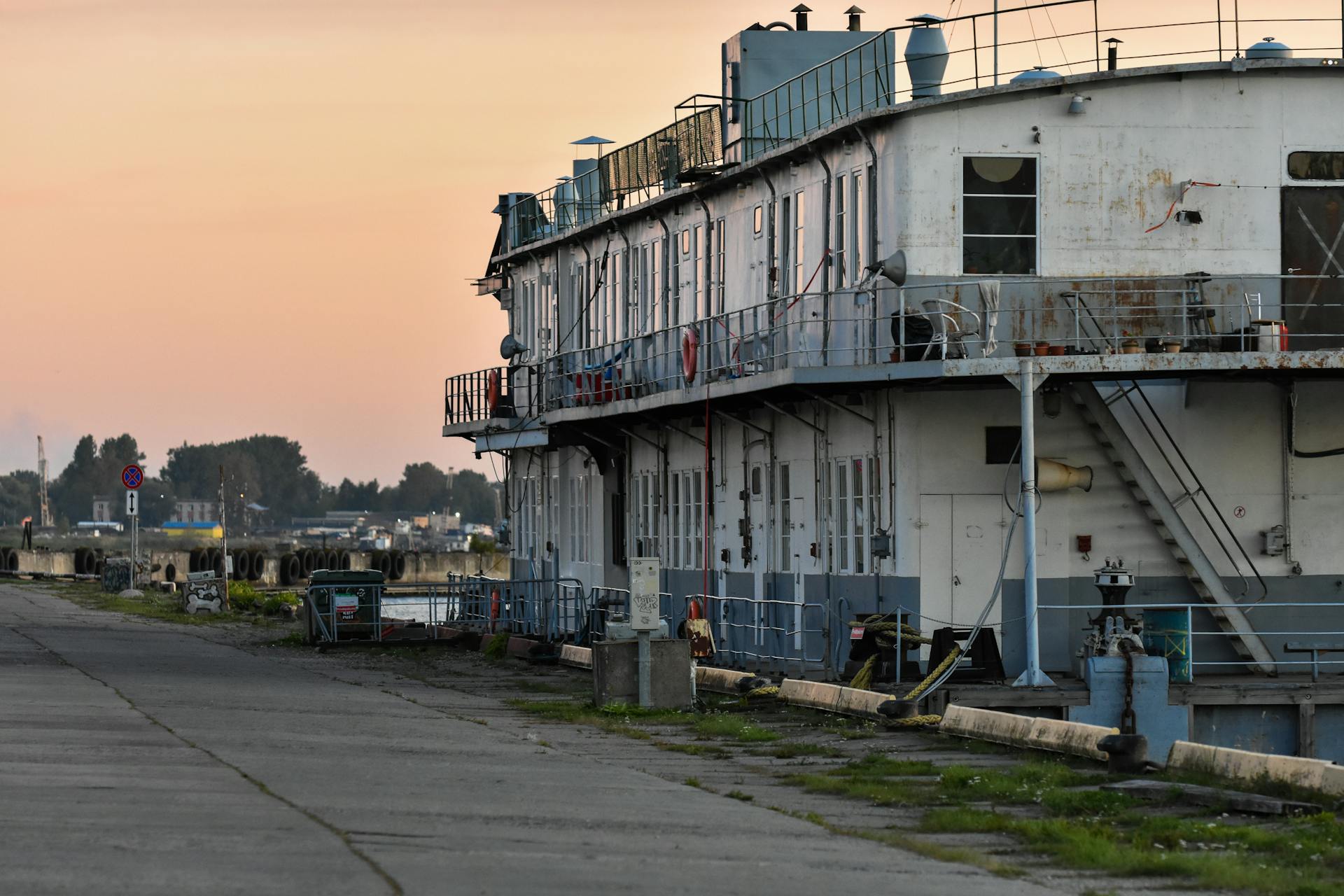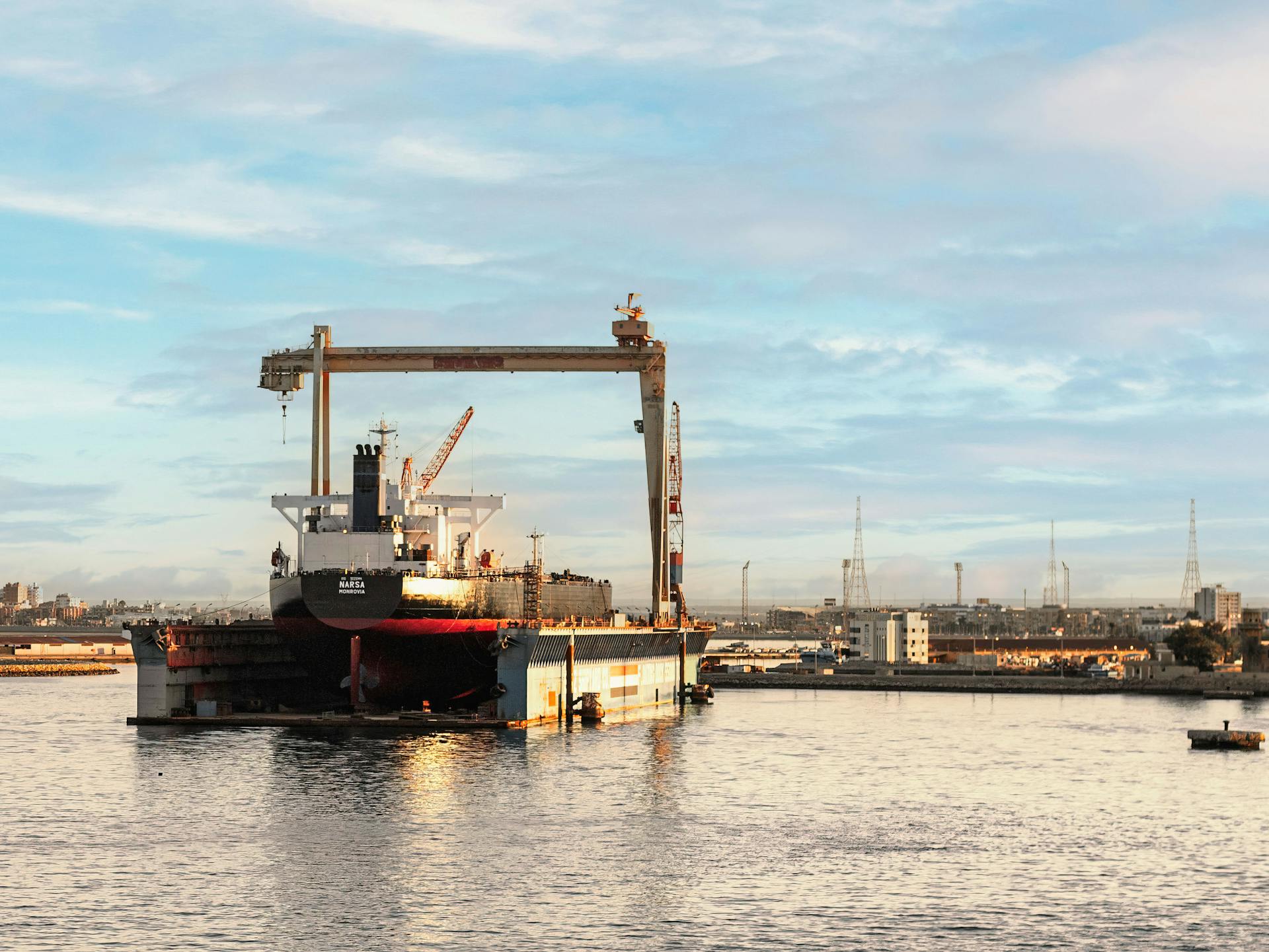
The Bethlehem Shipbuilding Corporation had a profound impact on the world's maritime industry, and its legacy continues to influence shipbuilding practices today.
The corporation's innovative approach to ship design and construction was evident in its use of electric cranes, which greatly increased efficiency and productivity.
One of the most notable aspects of the Bethlehem Shipbuilding Corporation was its ability to adapt to changing market demands, producing a wide range of vessels including passenger liners, cargo ships, and naval vessels.
The company's commitment to innovation and quality helped establish it as a leading player in the shipbuilding industry, earning the trust of clients and customers worldwide.
Discover more: Dalian Shipyard
About the Shipyard
Bethlehem Shipbuilding Corporation was a major player in the shipbuilding industry, with a rich history that spans over a century. The company was established in 1905 and went on to become one of the largest shipbuilding companies in the United States.
Bethlehem Shipbuilding Corporation owned or operated several shipyards across the country, including the Bayonne Naval Drydock in New Jersey, which was used for ship repairs and was staffed by workers from the Hoboken Shipyard.
For your interest: Bethlehem Sparrows Point Shipyard

The company's growth was fueled by its partnership with the U.S. Navy and U.S. Maritime Commission during World War II, during which it constructed over 1,100 ships, employing more than 180,000 people.
Bethlehem Shipbuilding Corporation's success lasted for decades, but it eventually shifted its focus to steel production in 1997.
Here is a list of some of the shipyards owned by Bethlehem Shipbuilding Corporation:
- Bethlehem Wilmington (Wilmington, DE)
- Hunter’s Point Dry Docks (San Francisco, CA)
- Bethlehem Sparrows Point Shipyard (Sparrows Point, MD)
- Union Iron Works (San Francisco, CA)
- Fore River Shipyard (Quincy, MA)
- Bethlehem Elizabethport (Elizabethport, NJ)
- Alameda Works Shipyard (Alameda, CA)
- Victory Plant Shipyard (Quincy, MA)
- Bethlehem Mariners Harbor (Staten Island, NY)
- Bethlehem Southwest Marine Terminal Shipyard (San Pedro, CA)
- Bethlehem Fairfield Shipyard (Baltimore, MD)
- Bethlehem Hingham Shipyard (Hingham, MA)
- Bethlehem Atlantic Works (Boston, MA)
- Bethlehem Brooklyn Shipyard (Brooklyn, NY)
- Hoboken Shipyard (Hoboken, NJ)
- Bayonne Naval Drydock (Bayonne, NJ)
- Bethlehem Pennsylvania Shipyards (Beaumont, TX)
Asbestos Use and Risks
Bethlehem Shipbuilding Corporation used asbestos in its shipbuilding activities for decades, putting hundreds of thousands of workers at risk of exposure and asbestos-related illnesses. This was during the company's busiest period, coinciding with the peak use of asbestos in the industry.
Asbestos was prized for its ability to insulate and protect against fire, important properties in shipbuilding. It was also easy to get and inexpensive, which made it a popular choice for many shipyards.
Some of the many asbestos products BethShip workers installed in ships include insulation, pipe lagging, textiles, gaskets, valves, boilers, pumps, floor tiles, ceiling tiles, and adhesives. These products were used in hundreds of components that went into ships.
Workers who used asbestos textiles, burners, shipfitters, boiler room workers, ship repair workers, insulation installers, technicians, and general laborers were all at risk of exposure to asbestos. This was because many products that went into building ships contained asbestos.
Here are some of the manufacturers that shipped asbestos-containing products to BethShip:
- Armstrong Contracting and Supply Corporation
- Pittsburgh Corning
- Johns-Manville
- Ruberoid
- McCormick Asbestos Company
- Eagle-Picher Industries
Asbestos is a known carcinogen, and when disturbed, asbestos fibers can be easily inhaled or ingested. The fibers are tiny, odorless, and undetectable by the human eye.
History and Impact
The Bethlehem Shipbuilding Corporation has a rich history that spans over a century. It was created in 1907 by the Bethlehem Steel Corporation after it bought the Union Iron Works shipyard.
The company's shipbuilding division began in Quincy, Massachusetts, but later moved to Sparrows Point, Maryland in the 1960s. This strategic move allowed the company to expand its operations and reach new heights.
Bethlehem Shipbuilding was considered the #1 shipbuilding company in the 1940s, according to Time magazine. This impressive ranking was a testament to the company's exceptional capabilities and expertise.
A fresh viewpoint: Bethlehem Shipbuilding San Pedro
During World War II, BethShip played a crucial role in the war effort, building more ships than any other company and employing nearly 200,000 people. This massive effort showcased the company's ability to adapt and respond to the needs of the nation.
Shipbuilding continued to be a significant part of the company's operations until 1997, when it shifted its focus to steel operations, tunnel construction, and ship repair and refurbishment. This change marked a new era for the company, but its legacy as a pioneering shipbuilder remained intact.
Lawsuits
Lawsuits related to Bethlehem Shipbuilding Corporation have been filed by many former workers who developed asbestos illnesses. These lawsuits highlight the risks of working at BethShip facilities.
Many of these lawsuits were filed against the asbestos companies that supplied Bethlehem. A worker who sued Armstrong, for example, developed an asbestos illness after working as a rigger at the Bethlehem Steel Key Highway Shipyard from 1964 to 1982.
He was exposed to asbestos fibers when working near laggers, who installed or repaired asbestos pipe insulation. This is just one example of how workers were exposed to asbestos at BethShip facilities.
Another former worker sued Eagle-Picher after developing mesothelioma. He worked with the company's insulating asbestos cement at BethShip facilities.
If you worked at a BethShip facility and now have an asbestos disease, you may be eligible to file a lawsuit or make a claim with an asbestos trust fund.
Sources
- https://en.wikipedia.org/wiki/Bethlehem_Shipbuilding_Corporation
- https://mesothelioma.net/bethship-bethlehem-shipbuilding-corporation/
- https://www.mesotheliomalawyercenter.org/veterans/navy/shipyard-and-asbestos/bethlehem-shipbuilding-corporation/
- https://en.wikipedia-on-ipfs.org/wiki/Bethlehem_Shipbuilding_Corporation
- https://en.wikipedia.org/wiki/Bethlehem_Shipbuilding_San_Pedro
Featured Images: pexels.com


